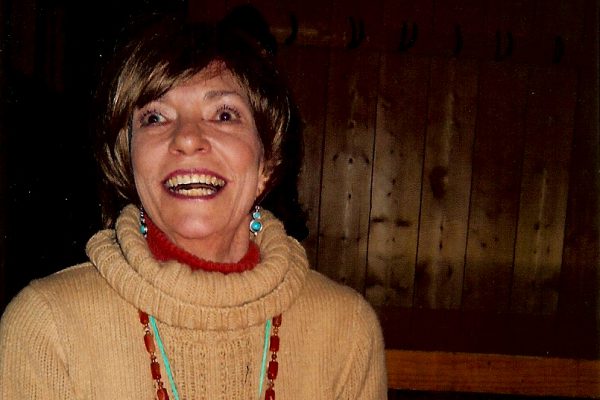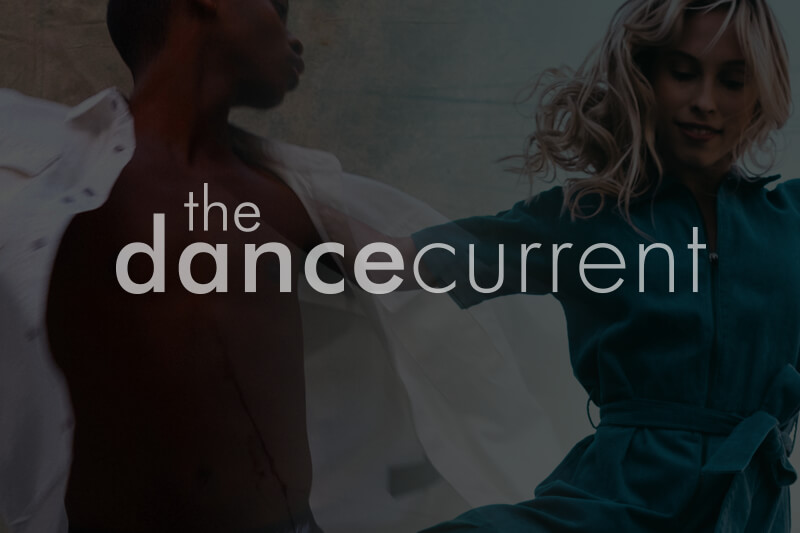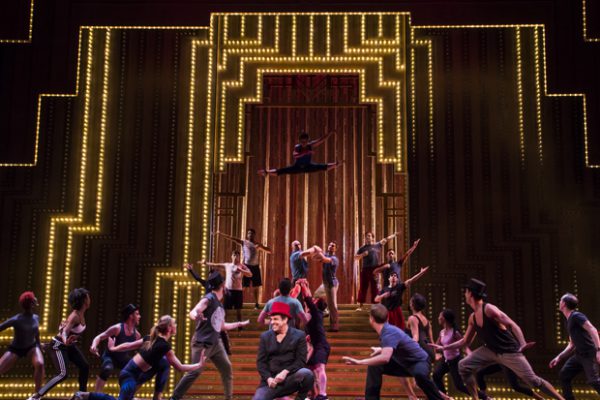Bob Fosse cast Louise Quick as a Kit Kat Klub dancer for his movie version of Cabaret in 1971. In the film, she is introduced by the Master of Ceremonies (played by Joel Grey) as ‘Helga’ in the lineup of dancers during the first number, Willkommen. Louise went on to work with Fosse on a number of subsequent projects, including Liza with a Z and Pippin. Filmmaker Moze Mossanen conducted an interview with Quick on December 24, 2012. Their conversation has been edited and condensed.
Moze Mossanen: Tell me about your background–where you were born, where you studied and what brought you to New York.
Louise Quick: I grew up in Mobile, Alabama. My dance teacher took me to New York when I was eleven. I had six summers to study before I moved up for good when I was sixteen in my senior year. I also studied with a Russian ballet mistress for three years and was at the American School of Ballet as well. But my first job was in a nightclub in Pittsburgh. It was a mistake–I should never have gone to a place like that when I was seventeen. But then I started working in stock and my first Broadway show Bye Bye Birdie happened in 1960. I think I did a total of nine Broadway shows including No Strings (the national tour), Golden Boy and Half a Six-Pence. They were all good shows; my only flop was Fig Leaves Are Falling, unfortunate because I had a big role in it. David Cassidy played my little brother and Barry Nelson played my father–all back in 1969. We had four big performances and then it closed! George Abbott directed it and Eddie Gasper, who was one of Bob Fosse’s assistants, choreographed it.
And then there was [the original production of] Sweet Charity, a revival of Cancan at City Centre and Pippin, of course. My last Broadway show was The Best Little Whorehouse In Texas. Then I got into choreographing which I didn’t enjoy that much.
I [did] a production of Sweet Charity and a production of Pippin and a couple of other original shows. I discovered I loved directing. You see, my knees were going and I didn’t have the nerve to start all over as actor. But then I was out of the business and I was a telemarketer for a few years. The last ten years or so I’ve been toe dipping, just doing what people ask me [to do]. I directed a production of Pippin in St. Louis, which was exciting. And I assisted Liza Minnelli on her show (Liza’s at the Palace) which was great. And then I had a cabaret show of my own a few years ago but Hurricane Irene hit and that was that. It left me homeless; on top of that, I had cancer. But I’m okay now. Right now I’m still living out of a suitcase but I’m having some work done on my home which is why I’m not working on my show right now. I don’t know if I’ll be ready for the spring but maybe for the fall. And that’s where I’m at right now.
MM: Tell me about the time you first met Bob Fosse.
LQ: In 1957 I auditioned for him for Redhead on Broadway but I was eliminated immediately. Then, a few years went by, and I saw the Actor’s Fund benefit for Sweet Charity [prior to its Broadway opening] and I knew I had to do it. Six months later they were auditioning for replacements and I auditioned and I got it. I did Charity for about a year. That was in 1966. And then, lo and behold, a few years later I got a letter to do the movie [version] of Sweet Charity. I couldn’t believe it because I heard you had to audition for Fosse for anything, even if he knew you. But he called me up and I did the Sweet Charity. movie. And then I got a call to do the movie of Cabaret. I thought, ‘Does this mean I’m a real Bob Fosse dancer! [laughs]’ After Cabaret, I stayed in Germany for a year and after I came back, Bob called again and said ‘I’m doing a new Broadway show and would you assist me?’ Well, I had never assisted before and had no idea what assisting was about. I told him that I had worked so hard as a performer [and wanted to stay a performer]; so, no. But later he called again and said ‘I’m doing a TV show and it’s got only about five weeks of rehearsal.’ This time, I said ‘okay’; and I’m glad I did because that show ended up being Liza with a Z. And then came Pippin where I assisted Bob as well. So, I’m the only living person who worked with Bob on all three of his triple-crown projects. (Cabaret, Liza with and Z and Pippin.)
MM: He must’ve thought highly of you to do all that work with him.
LQ: I never had much self-esteem and never thought about that until years later. But now, talking with people about those days, I say to myself: ‘My goodness, I was really lucky.’ I started realizing that people are really interested in these shows and movies and really respond to them. I can see that they were a huge part of our showbiz history.
MM: How much preparation did you do for Cabaret before you left to shoot in Germany?
LQ: We rehearsed for six weeks in Germany and the shooting was around six weeks for the dance sequences. And then the film went on location and I went along with the crew where I stood in for Liza. But I know Bob did a lot of preparation before he left for Germany. He had one German film assistant director in Germany [Wolfgang Glattes] but it was very possible that he did a lot of preparation with his American dance assistant, John Sharpe, most likely at the Broadway Arts studio in New York. [His second dance assistant, a German, was Uta Beil.]
MM: I can only imagine getting the gig to direct Cabaret was a big deal for him.
LQ: Oh, sure. Remember that Fosse was not a sought-after movie director at that time. Sweet Charity [which had been released a few years before] was not well received and he was just floating, becoming a sponge, travelling, taking acting classes, doing whatever he could do to sharpen his game.
MM: Tell me about your arrival in Germany to shoot the movie and your meeting with the other cast members and how rehearsals began.
LQ: There were two dancers hired from America–Kathryn Doby and myself–and four German dancers hired in Germany. Kathryn and I stayed in a hotel in the Schwabing district, near Leopoldstrasse in Munich. And we started working right away with the dancers and Bob’s two assistants and with Fred Werner, the rehearsal pianist. How can I explain how it was to work with him? It’s so hard to put into words. Let’s just say that the experience starts at the moment you know you’re going to work with him. The other dancers spoke a little English but there was such mutual respect between Bob and his crew and the German dancers. You see, the German dancers were not accustomed to being treated so well. For example, when he excused a dancer during the auditions, he would shake their hand and say ‘Thank you for coming.’ They had never been spoken to like that before. So it was easy to see why the dancers in Germany fell in love with him. And that expression ‘thank you for coming’ became a [catchphrase] in Europe. It became a funny line–as a way to show respect for someone. And because of that respect, he got about 150 percent from everyone. When he works, he works full out. There’s no ‘marking.”
MM: I read somewhere that some of the Germans who came across the production were quite uncomfortable with part of their painful history being revisited again. Did you come across any of that?
LQ: When we were shooting in the studio it was not apparent. But on location it was different. There were a few incidents. When we filmed the song, Tomorrow Belongs to Me [which is sung by a member of the Nazi Youth], there was one person in the biergarten who really freaked out and had to be escorted off the set. He got totally wrapped up in the Nazi fervour shown in the scene. And then there was also one neighbourhood street scene where it was very uncomfortable– the scene where there was a cop on a horse, an SS guard. It was a relatively poor neighbourhood, and there were some people there who got overtly nasty. And [there was] another incident with a friend of the still photographer, who was a former junkie and quite effeminate. A bunch of people took him into a store and beat him up. Not sure if the reason was drugs or his being an American associated with the film. It wasn’t a story that got around; they kept a lid on it.
MM: Were there any particular moments during rehearsals that stood out for you?
LQ: I remember one time we were working and it was just Ute [one of the dancers] and John [Fosse’s assistant] and Kathryn Doby and me. Bob wanted someone to do a flip but he would always do it himself to make sure it was safe. So he did it but he landed smack on his face. It was not good! But he quickly turns to us and says: ‘Don’t tell Gwen! Please, don’t tell Gwen!’ [Gwen Verdon, Fosse’s wife at the time.]
MM: I also read that Gwen helped Bob a lot on the film.
LQ: Oh, absolutely. When Bob was unhappy with all the costumes made for the girls [the Kit Kat Klub dancers], it was Gwen who went out to the thrift shops and brought in racks of clothes for us to wear. And it was Gwen who found the gorilla head in New York and then flew to Germany with the head sitting on her lap on the plane! [The head was part of the gorilla costume that Louise Quick wore in the If You Could See Her Through My Eyes number with Joel Grey.]
MM: What was it like being in that gorilla costume for so long?
LQ: It wasn’t great [laughs]. For one thing, I couldn’t see through the mask. It wasn’t fitted and I was completely in the dark while dancing. With the [Kit Kat Klub] stage being four feet off the floor, I was also always afraid of falling over the edge. In rehearsal, Bob had me rehearse with a bag over my head. With all the turning I did and all the chaînés, it was very hard. And, that moment where I was trying to look into my gorilla purse: Couldn’t see a thing! But I figured out that by moving my head or jaw a certain way, I could bring up my head to see through the nostrils. And that’s how I got through it!
MM: Can I ask how much you were paid for your work back then?
LQ: I made about $200 a week – for both rehearsals and shooting. The German dancers made about 200 Deutsche marks, which, after conversion, was something like $50 a week American.
MM: Were there any moments during shooting that you remember most vividly?
LQ: I remember the extras in the audience. I remember loving their reactions and their acting. They were very much into their parts. And it goes back to Bob treating them so well – as human beings. These actors/extras were not used to that! And when it came to their close-ups, they were treated like stars. They had makeup people, wardrobe… and they were lit as if they were leads. Bob called each one by their name. And it spilled over. Everyone felt they were part of the production. But there was also a feeling that we knew that something really good was being done. There was always this excitement in the air. A tingling. The stagehands bent over backwards to please Bob. At six o’clock at night when the whistle would go off, none of the stagehands would stop working until Bob excused them. That was the kind of respect they had for him.
MM: Tell me about rehearsing and shooting the Mein Herr number, the dance most closely associated not only with Liza Minnelli but with the movie as well.
LQ: Mein Herr was very difficult physically. The thing I remember most is that grotesque, machinelike and bitter anger that comes from the choreography, especially the choreography given to the dancers behind Sally. See, the chorus is behind Sally Bowles but we are doing something entirely different than what she was doing. Sally is flirting but the girls in the background are in counterpoint in some way. It’s almost like a miniature of the movie itself–Sally and her story amidst this Nazi horror story taking place. And you know… I’m not even sure it was a conscious thing on Bob’s part. Not something he did deliberately but something in his subconscious that made it come out that way.
MM: Was anyone hurt physically during the rehearsals or shooting?
LQ: Yes, but we never told Bob if something hurt, because it would really affect him. He would care so much and we didn’t want him distracted. I’ll tell you a little story. It took three days to shoot Mein Herr but on the second day one of the girls didn’t show up for shooting. We learned that she had tried to commit suicide the night before. Nobody told Bob that this had happened–he would’ve been devastated. So Ute took her place and, not knowing the choreography as well as the rest of us, her back became so scraped that the skin peeled back and there was bleeding. But she would never show her back to Bob, always sitting facing him so that he would not know. My own knee problems all started in Mein Herr.
MM: How long was the overall rehearsal and shoot?
LQ: Six weeks to rehearse all the dance and song numbers; six weeks to shoot them, including Liza’s Cabaret number and then six weeks to shoot all of the studio, exterior and on-location scenes. All the interior scenes [like Sally’s apartment] were shot in a studio in Munich, with the street scenes filmed in various locations in Berlin. And the castle was in [the lake district of Eutin; it belonged to the Duke of Oldenberg.] Bob also had me on hand to do all of Liza’s footsteps [for the film’s sound effects recording] in some scenes, including the Cabaret number. I did it again for Liza for her Liza with a Z special a year later.
MM: I love the scene in the rowboat with the butler silently and stoically holding the champagne bucket while Sally, Brian and Max are frolicking around him.
LQ: Yes, but do you know who that butler was? He was the actual butler who once worked for the baron who lived in that castle. Bob heard about this and hired him to become the technical adviser for the dinner party. He had the butler instruct the actors playing the waiters to do it the way it was supposed to be done. Bob did the same thing with Fritz’s and Natalia’s wedding in the synagogue. He wanted the authenticity of a real Jewish wedding so he asked a rabbi to help out. The rabbi asked to see the script but Bob showed him a watered-down version… well, you can only guess why! Anyway, the rabbi ended up doing it for the film.
MM: Did you know that Bob was going to cross-cut many of the dances with other dramatic elements?
LQ: No, not at all. We had no idea what they would look like. I think he wanted us to stay in the reality and feeling of the dance without knowing the larger picture; it might’ve been distracting.
MM: What do remember most about Liza Minnelli and Joel Grey?
LQ: Liza and Joel are the epitome of class. Just to watch the three of them work was such a treat. There was a great interaction between all of them. It was a great thing to watch.
MM: Given the incredible success of the movie all over the world, as well as its being recognized as one of the top musicals of all time, did it change your life in any way?
LQ: It didn’t change my life but when people find out I was in the movie, their faces light up. If it did change me, it changed me inside, in that it gave me more self-esteem. I can look at the movie, look at how great it is and what a great piece of art it is and say: ‘I was a part of that.’
The 40th anniversary of Cabaret the movie was celebrated recently with the Warner Brothers re-release of the groundbreaking musical on Blu-ray. See Moze Mossanen’s review in the March/April 2013 edition of The Dance Current.
Learn more >> For an in-depth and excellent look at the making of the movie, read Cabaret by Stephen Tropiano, published by Limelight Editions, 2011. More information about Cabaret can also be found at officiallizaminnelli.com
Tagged: Musical Theatre, International





